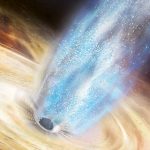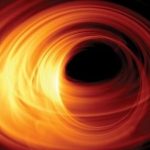4 things we’ll learn from the first closeup image of a black hole0
- From Around the Web, Space
- April 2, 2019
Event Horizon Telescope data are giving scientists an image of the Milky Way’s behemoth

Event Horizon Telescope data are giving scientists an image of the Milky Way’s behemoth

A team of physicists from the Joint Quantum Institute, the University of Maryland, the University of California Berkeley and Perimeter Institute for Theoretical Physics has implemented a test for quantum scrambling, a chaotic shuffling of the information stored among a collection of quantum particles. The team’s experiment, carried out on a group of seven ions, demonstrated a new way to distinguish between scrambling and true information loss.

Astronomers have detected a stealthy black hole from its effects on an interstellar gas cloud. This intermediate mass black hole is one of over 100 million quiet black holes expected to be lurking in our Galaxy. These results provide a new method to search for other hidden black holes and help us understand the growth and evolution of black holes.

Scientists have charted the environment surrounding a stellar-mass black hole that is 10 times the mass of the Sun using NASA’s Neutron star Interior Composition Explorer (NICER) payload aboard the International Space Station.

Interplay of twisting magnetic field, ‘negative-energy’ particles

The supermassive black hole in the center of the Milky Way seems to be pointing a radio jet directly towards us.

The light released from around the first massive black holes in the universe is so intense that it is able to reach telescopes across the entire expanse of the universe.

A bright flare nicknamed “The Cow” may have been the birth of a black hole or neutron star.

Humanity’s most far-flung spacecraft, NASA’s 41-year-old Voyager 1, has poked a hole in a long-shot theory of dark matter.

Black holes are among the most mysterious places in the universe; locations where the very fabric of space and time are warped so badly that not even light can escape from them.